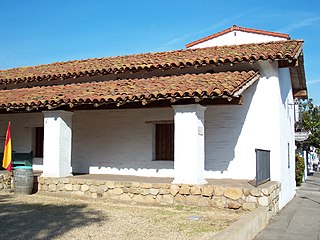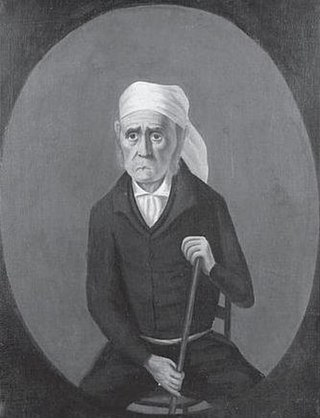Luis Antonio Argüello was the first Californio (native-born) governor of Alta California, and the first to take office under Mexican rule. He was the only governor to serve under the First Mexican Empire and also served as acting governor under the subsequent provisional government, which preceded the First Mexican Republic.

Californios are Hispanic Californians, especially those descended from Spanish and Mexican settlers of the 17th through 19th centuries before California was annexed by the United States. California's Spanish-speaking community has resided there since 1683 and is made up of varying Spanish and Mexican origins, including criollos, Mestizos, Indigenous Californian peoples, and small numbers of Mulatos. Alongside the Tejanos of Texas and Neomexicanos of New Mexico and Colorado, Californios are part of the larger Spanish-American/Mexican-American/Hispano community of the United States, which has inhabited the American Southwest and the West Coast since the 16th century. Some may also identify as Chicanos, a term that came about in the 1960s.

Juan Bautista Valentín Alvarado y Vallejo usually known as Juan Bautista Alvarado, was a Californio politician that served as governor of Alta California from 1837 to 1842. Prior to his term as governor, Alvarado briefly led a movement for independence of Alta California from 1836 to 1837, in which he successfully deposed interim governor Nicolás Gutiérrez, declared independence, and created a new flag and constitution, before negotiating an agreement with the Mexican government resulting in his recognition as governor and the end of the independence movement.
José Francisco Ortega was a New Spanish soldier and early settler of Alta California. He joined the military at the age of twenty-one and rose to the rank of sergeant by the time he joined the Portola expedition in 1769. At the end of his military duty he would be granted land which he named Rancho Nuestra Senora del Refugio near Santa Barbara.

José Antonio de la Guerra y Noriega was a Californio military officer, ranchero, and founder of the prominent Guerra family of California. He served as the Commandant of the Presidio of Santa Barbara and the Presidio of San Diego.
José Darío Argüello (1753–1828) was a Querétaro-born Californio politician, soldier, and ranchero. He served as interim Governor of Alta California and then a term as Governor of Baja California.

The Casa de la Guerra was the residence of the fifth commandant of the Presidio de Santa Barbara, José de la Guerra y Noriega, founder of the Guerra family of California from 1828 until his death in 1858. Descendants of José lived in the home until 1943. The site is currently owned and operated by the Santa Barbara Trust for Historic Preservation as a historic house museum. The address is 15 East De la Guerra Street, Santa Barbara, California.

Pablo de la Guerra was a Californio politician, judge, and signer of the Californian Constitution in 1849. He served several terms in the California State Senate between 1849 and 1862, and as acting lieutenant governor of California from 1861 to 1862.

The Paseo de la Guerra is a complex of historic buildings in downtown Santa Barbara, California. Since 1977 it is listed in National Register of Historic Places. It is named for the Guerra family of California, a historically prominent Californio family in Santa Barbara.

The Ávila family was a prominent Californio family of Spanish origins from Southern California, founded by Cornelio Ávila in the 1780s. Numerous members of the family held important rancho grants and political positions, including two Alcaldes of Los Angeles.
Rancho El Conejo was a 48,572-acre (196.56 km2) Spanish land grant in California given in 1803 to Jose Polanco and Ygnacio Rodriguez that encompassed the area now known as the Conejo Valley in southeastern Ventura and northwestern Los Angeles Counties. El Conejo is Spanish for "The Rabbit", and refers to the many rabbits common to the region. The east-west grant boundaries approximately went from the border of Westlake Village near Lindero Canyon Road in the east to the Conejo Grade in the west. The north-south borders extended from the top of the Simi Hills at the end of Moorpark Road in the north to Hidden Valley in the Santa Monica Mountains in the south. The rancho is the site of the communities of Newbury Park, Thousand Oaks, and Westlake Village.
The Berreyesa family is a prominent Californio family of Northern California. Members of the family held extensive rancho grants across the Bay Area during 18th and 19th centuries. Numerous places are named after the family, including the Berryessa district of San Jose and Lake Berryessa in Napa County.
Rancho San Julian was a 48,222-acre (195.15 km2) Mexican land grant and present-day ranch in present-day Santa Barbara County, California given in 1837 by Governor Juan B. Alvarado to José de la Guerra y Noriega. The grant name probably refers to José Antonio Julian de la Guerra. The grant was located west of present-day Santa Barbara.
Rancho Las Posas was a 26,623-acre (107.74 km2) Mexican land grant in present-day Ventura County, California. It was given in 1834 by Governor José Figueroa to José Antonio Carrillo.
Rancho Todos Santos y San Antonio was a 20,772-acre (84.06 km2) Mexican land grant in present-day Santa Barbara County, California given in 1841 by Governor Juan B. Alvarado to William Edward Petty Hartnell. The grant extended along San Antonio Creek and encompassed present-day Orcutt., northwest of Lompoc
Santiago Argüello (1791–1862) was a Californio, a soldier in the Spanish army of the Viceroyalty of New Spain in Las Californias, a major Mexican land grant ranchos owner, and part of an influential family in Mexican Alta California and post-statehood California.

María de las Angustias de la Guerra, known simply as Angustias de la Guerra, was Californio historian and socialite. A member of the prominent Guerra family of California, she played an important role in defending women's property rights in the California Constitution while it was being drafted during the Monterey Constitutional Convention of 1849. Her memoirs, "Ocurrencias en California" is an important historical account of Californian history in the 19th century.

The Carrillo family is a prominent Californio family of Southern California. Members of the family held extensive rancho grants and numerous important political positions, including Governor of Alta California, Mayor of Los Angeles, Mayor of Santa Barbara, Mayor of Santa Monica, and a signer of the Californian Constitution.

The Pico family is a prominent Californio family of Southern California. Members of the family held extensive rancho grants and numerous important positions, including Governor of Alta California, signer of the Constitution of California, and California State Senator, among numerous others. Numerous locations are named after the family across California.














